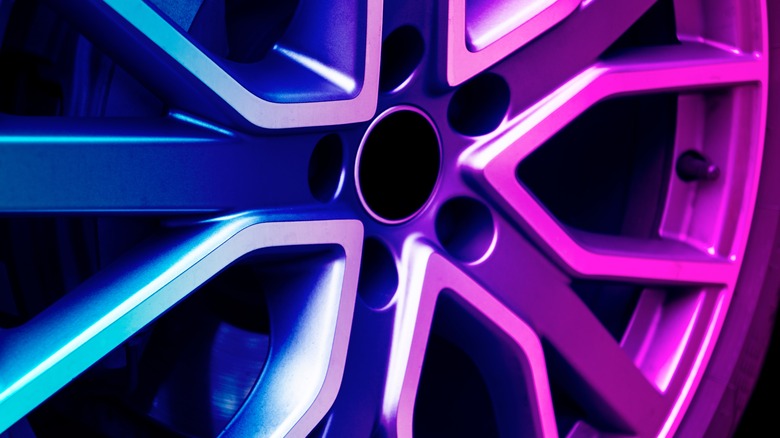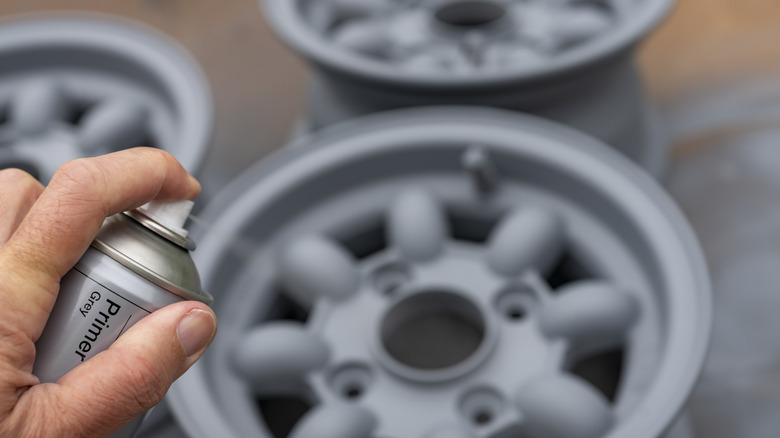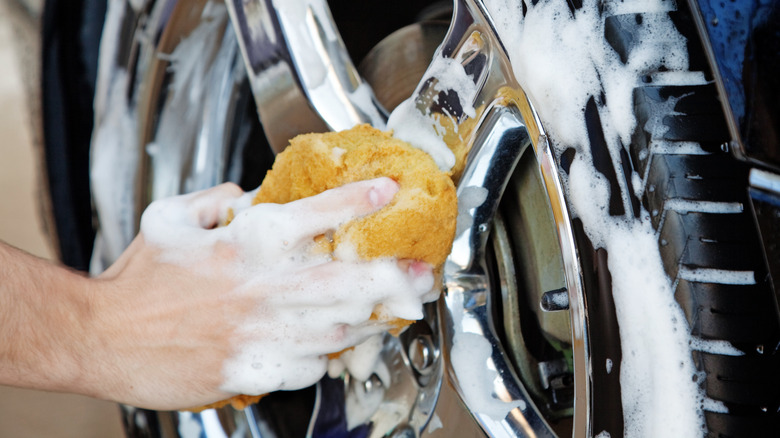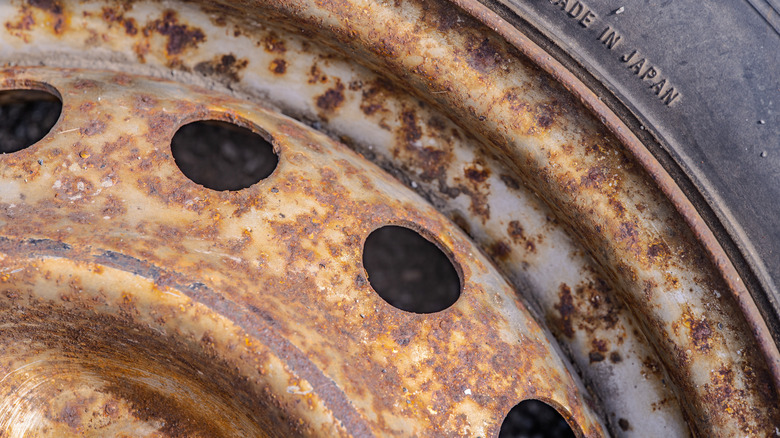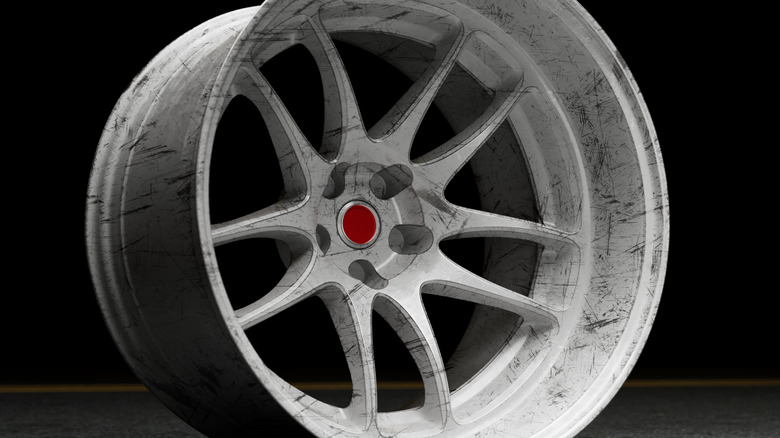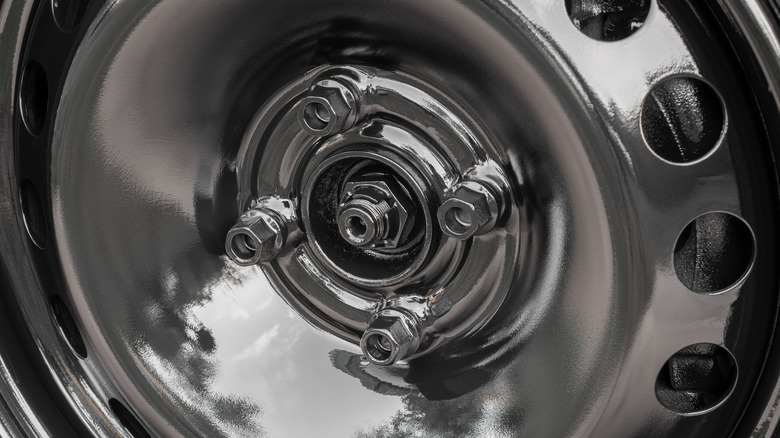5 Tips & Tricks For Painting The Wheels On Your Car Or Truck
Whether you're driving an old or new car, you might be on the lookout for ways to jazz up the vehicle's appearance. There are countless ways you can go about giving your vehicle a refresh by touching up elements of both its interior and its exterior. If you want to make a dramatic impact in the latter category, washing your car the right way is a solid place to start, as is touching up your wheels with a fresh coat of paint.
There are several ways to approach painting your car's wheels. Whether you want to give them a fresh alloy look, a sleek matte black finish, or something a little more extravagant, it's important to do the job right. Even as painting your car's wheels can transform your vehicle from the ground up, a sloppy paint job can have just the opposite effect. Here are a few tips and tricks that should help you paint the wheels of your car or truck like an automotive pro.
Choose the right paint and primer for the job
You should always make sure you have the correct materials on hand before undertaking any automotive upgrades. When prepping to paint your wheels, pay particular attention to the paint you're using, ensuring you've selected spray paint designed for use on metal or plastic wheels. You also want a paint that is corrosion and weather-resistant. Rust-Oleum and Eastwood are two of the more popular spray paint brands for car or truck wheels, but if you're still uncertain which paint to use, consult an automotive professional for advice.
You will also want to confirm whether or not the paint you're using requires a primer before application because not all of them do. Whatever the case, using two to three coats of primer can help protect your paint against flaking and corrosion. The good news is you should be able to use most primers on the market on your wheels. While primers come in many colors, gray is the go-to for many professionals. Still, the primer color may affect the final look of the paint, so take that into account before you begin.
Make sure you are working with a clean surface
Before you can paint the wheels on your car or truck, you need to make sure you are working with a nice, clean surface. That means you'll want to give your wheels a full-on deep clean ahead of your paint job. To properly clean your wheels, you'll need a sponge or soft-bristle brush, a bucket of water, and a soap approved for use on an automobile.
With those tools in hand, rinse your wheels with a hose, removing large buildups of dirt, grease, and brake dust. Then, combine the water and soap in the bucket, dip your sponge or brush into the bucket, and start scrubbing the wheels. Be thorough in your cleaning, scrubbing the wheel from the outside in and paying particular attention to the inner parts of the frame. Once you've cleaned the surface, rinse the wheel and wait until the surface is dry before you begin priming or painting. You should also avoid using wax or polish after you clean the wheel, as this may prevent paint primers from being effective.
Sand down any rusted areas
If you're driving an older vehicle, you may have more on your mind than merely jazzing up your wheels with a fresh coat of paint, as the buildup of rust can be a legitimate problem for steel, chrome, and alloy rims. If you are dealing with rust on your wheels, you will need to scrub away as much of it as possible before you start the process of priming and painting.
The purpose of scrubbing the rust on your wheel is not to remove it entirely but to smooth the surface out as much as possible before applying primer, paint, and a clear coat so the rough spots aren't visible. Specialized tools like a Dremel or angle grinder can help smooth out rust and scratches in metal wheels, but that may be more of an investment than some DIYers are comfortable with.
Thankfully, with a little extra time and effort, you should still be able to smooth those surfaces out using sandpaper, beginning with 400 grit and working up to 1,000 grit paper if needed. Once you've smoothed out the wheel, wipe it down with rubbing alcohol and a lint-free towel to remove any dust.
Do not paint the wheel with the tire still on if possible
You will need to remove the tire and wheel from your car before you begin to ensure you don't inadvertently splash painting materials onto your vehicle. Pro-tip: after removing the tires, consider cleaning your vehicle's wheel wells, as they can get pretty gritty on the road. With the tires of your car, you should consider removing the tire from the wheel before painting. This not only allows you to completely cover the surface area of the wheel with primers, paints, and sealants, but it will also ensure that residue from those liquids doesn't adhere to the tire.
Of course, even legit automotive DIYers may not possess the tools to remove a tire from a wheel, so we'd be remiss if we didn't offer a tire-on solution for wheel painting. The first option is to coat the tire with a liberal amount of a tire-shine gel, as it should help prevent any paint or primer from adhering to the rubber should it come into contact. Another effective trick to keep paint off your tire is to insert index cards into the space between the tire and wheel to form a protective cone between the surfaces.
Don't skimp when it comes to applying a clear coat protectant
Some folks believe clear coat protectants are necessary with certain types of paint. Even as hitting your wheels with a clear coat adds an extra step to the process, it's a step you shouldn't skip. Most of us do, after all, rely on a clear coat to help protect our car's paint, so it stands to reason such protectants can perform the same service for freshly painted wheels. As it happens, clear coat protectants also offer some of the same benefits as a primer, only they form a protective outer layer to shield your paint against the elements and may even help prevent scratches from rocks and debris and damage caused by salts used on snowy roads.
Many clear coat products are also equipped with agents that protect from UV damage, which prevents fading from extended exposure to sunlight. As with a paint primer, you should be able to use virtually any paint sealant on the market for the wheels of your car or truck. The application process is also relatively easy, as most protectants come in spray-on cans. A clear coat will, however, leave a glossy finish on your paint job, so if a matte look is your goal, you may want to abstain from use.
